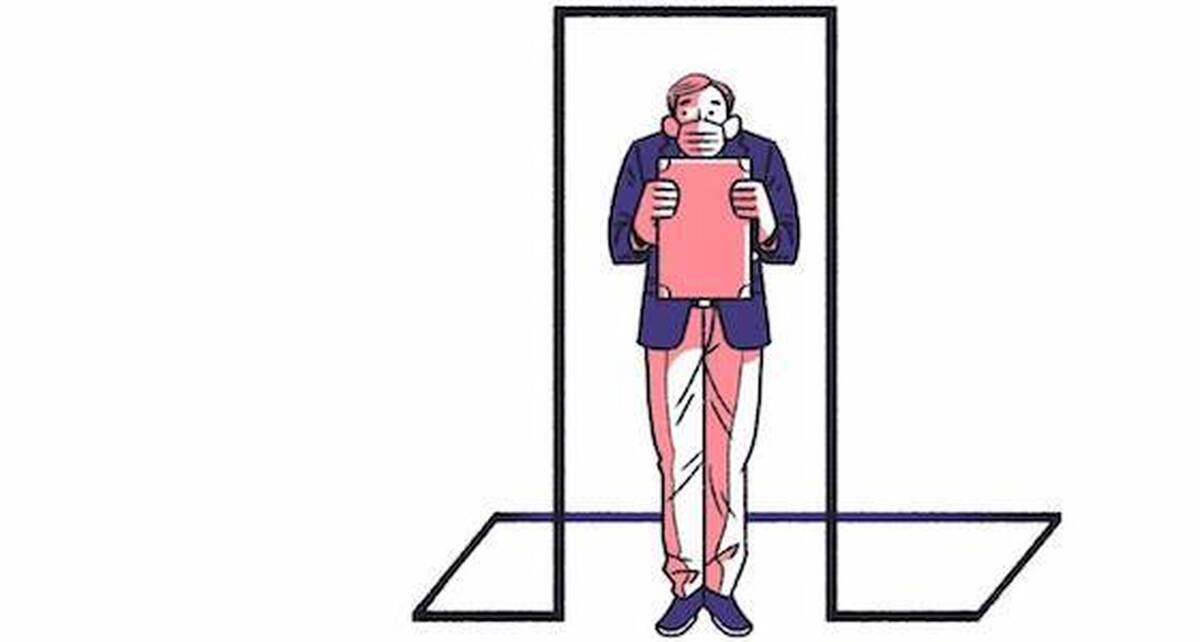Organizations Leadership Oct 12, 2020
What Companies Can Do to Encourage Compliance with COVID Safety Measures
Tips for thinking through “friction points” and making new habits stick.

A lot of effort goes into safely reopening offices, daycares, and other public spaces. Furniture has to be reorganized, ventilation reconsidered, touch-free devices installed, and signage added to reduce occupancy and encourage social distancing—among many other measures.
But ultimately, the effectiveness of any measure hinges largely on people’s willingness to comply with it. In order to stay safe in public spaces during a global pandemic, individuals need to fundamentally change how they behave.
Unfortunately, convincing people to change their behavior can be an uphill battle, especially when those changes are tedious or unpleasant. Getting those changes to stick is harder still.
Loran Nordgren, an associate professor of management and organizations at Kellogg, compares it to making an ambitious New Year’s resolution, like eating better or getting more exercise. “The new behavior persists for a while, and then it just tends to atrophy,” he says.
Nordgren is currently consulting with several organizations on how to get people to comply with new COVID-19 safety measures. He finds it helpful to think about the challenge in two ways: in terms of the forces that lead people to resist changing their behavior, and in terms of the forces that could possibly be harnessed to fuel healthy changes. Here, he offers his perspective on how organizations can best manage these forces to keep everyone safe.
Resisting Changes
Nordgren advises that organizations first think though the specific moments where their safety protocols are likely to break down. He calls these moments “friction points.”
“For example, imagine you’re doing all these things to keep people distant, but then people are packed into the bathroom like sardines,” he says. “That moment does two things. First, it energizes the resisters. It gives them the opportunity to talk about how dumb, inconsistent, and hypocritical the protocols are. And second, once you begin to break the standard, even though it’s not your intent, it makes doing so more acceptable.”
That’s because our minds are very bad at judging the risks posed by COVID-19, which tend to be cumulative. Statistically, it’s considerably more dangerous to break the rules habitually than it is to do so rarely. Yet once we begin to break the rules at all—even unintentionally—and nothing bad happens to us, our natural tendency is to assume that the rule isn’t that important and to take less care in the future.
Once organizations have a sense of where these friction points are, they can then identify solutions for those moments. For a crowded bathroom, this might mean staggering breaks, assigning employees to different bathrooms, or specifying how and where the queues will form.
“Create rules about that moment, and be prepared to intervene when the rules aren’t being followed. And really think through: What about people who are couples? What about the people who say they have antibodies?” says Nordgren.
You also need to think through instances when a solution isn’t possible or practical. In one company Nordgren was speaking with, lunchtime offered a friction point without an obvious workaround.
“One of the blanket rules was just, ‘You have to keep your mask on.’ But they didn’t think that through: obviously you can’t eat with your mask on. And that friction point was a major force in this thing breaking down very quickly. Because now people are taking their masks off. Now it’s making these protocols seem almost like a farce.”
“We’re most profoundly persuaded by ideas and insights we generate ourselves.”
— Loran Nordgren
Organizations need to take steps to inoculate people against concluding that when the rules can’t be followed perfectly, they are no longer effective or necessary. “You want to create the narrative for them,” Nordgren says. “You tell people up front that we aren’t able to script every moment of the day and prepare them for that. Help them interpret those moments not as a signal that the protocols aren’t important and real, but instead that everyone has a role and choice to play in how they are being followed.”
This might mean acknowledging to employees that masks don’t need to be worn during lunchtime, but that employees have a responsibility to mitigate the risk by strictly adhering to other safety protocols while eating.
Fueling New Behaviors
In addition to curbing these moments of friction, organizations can also be proactive about encouraging individuals to make meaningful changes to their behavior.
What might this look like? In Nordgren’s view, there are limits to the effectiveness of pleading with people to comply or punishing them if they don’t. After all, these are external pressures that can fade quickly if pleas and punishments aren’t ever-present.
Instead, he suggests that organizations find ways to help employees, customers, or clients internalize the pressure to comply with safety rules.
“We’re most profoundly persuaded by ideas and insights we generate ourselves,” Nordgren says. “How do you get people to commit to safety on their own? How do you get people to arrive at these insights, as opposed to just feeling like its exerted from the outside?”
Norgren wants people to feel as though they’re entering into a social contract.
His inspiration for this idea, oddly enough, is his experience with community norms around picking up dog poop. In his previous neighborhood in Europe, norms around picking up were lax. But in his current neighborhood near Chicago, there is near-universal compliance.
“We’re talking about something that is unpleasant, at least at first. When I got a dog, that was one of the things that I was a little hesitant about. But, there feels like so much internalized pressure. The decision isn’t based on whether people are looking,” he says. “It’s just something you do, and if my wife and I forgot our poop bags, it would be mortifying. We have anxiety about that.”
Similarly, if individuals feel as though behaviors like masking, distancing, following quarantine orders, or limiting gatherings are simply something that one does—that it is a part of the social contract that you make with others in your organization and community—new behaviors are more likely to become enduring habits.
“We will get the occasional bad actor, but it’ll be rare,” says Nordgren.
Make It Easy
Nordgren also suggests that organizations consider whether they are making it easy to comply with safety measures. For instance, if you suspect that rules around mask-wearing could pose a challenge, brainstorm ways to make it easier to wear a mask—or to demand that others wear a mask.
One tip: give people the language to quickly and less painfully tell someone that they need to put their mask on. Because if that conversation is painful for people to have, they won’t have it.
He points to a strategy that his students have adopted in one of his classes. “They know exactly how much a minute of class time costs,” he says. That number—that value in dollars—has become a code that students can use to quickly but effectively communicate to a fellow student that they are being inconsiderate by taking up too much class time.
Organizations can also lean on cues in the physical environment—not just signs that tell people what to do, but cues that provide insight into why. Once again, Nordgren looks to dog ownership for an example. Just as dog owners are increasingly tying yellow ribbons to their dogs’ leashes as a signal that they are anxious and should be given space, organizations could provide individuals with a simple way to visually communicate that they or someone in their family is at an especially high risk of COVID-19 complications.
Finally, Nordgren points out the importance of intervening on day one. For instance, the day a gym reopens is the optimal time to instill, communicate, and enforce new rules.
“There’s a temporal dimension to this,” says Nordgren. “At the very beginning, people are trying to figure out, ‘Is this real?’” This makes it even more important to think through and solve for friction points before people begin to return.
“It can be tempting to not think about situations that are complicated and ambiguous,” he says. That would be a mistake.



